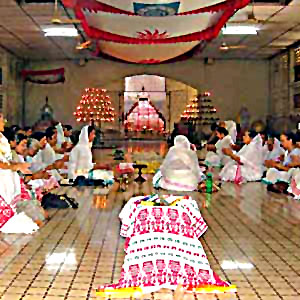 Namghar is a term for prayer room which is very popular in case of Assamese theatre. Because of its intimate association with traditional Assamese theatre, the architectural institution known as the nam-ghar has been hailed by some scholars as the `national theatre of Assam`. A unique feature of the neo-Vaishnava order of Assam is the satra or monastery, a repository of highly refined artistic forms, both performing and visual. The nam-ghar or kirtan-ghar is the prayer hall, the central structure in a satra complex, where various religious services as well as traditional performances are held. The village namghar, often an adjunct of the satra institution at the grass-roots level, is the focal point of religious, social, and cultural activities in an Assamese village, particularly wherever the influence of neo-Vaishnavism is strong and binding. The namghar is a shrine, a community hall, and a public auditorium all rolled into one.
Namghar is a term for prayer room which is very popular in case of Assamese theatre. Because of its intimate association with traditional Assamese theatre, the architectural institution known as the nam-ghar has been hailed by some scholars as the `national theatre of Assam`. A unique feature of the neo-Vaishnava order of Assam is the satra or monastery, a repository of highly refined artistic forms, both performing and visual. The nam-ghar or kirtan-ghar is the prayer hall, the central structure in a satra complex, where various religious services as well as traditional performances are held. The village namghar, often an adjunct of the satra institution at the grass-roots level, is the focal point of religious, social, and cultural activities in an Assamese village, particularly wherever the influence of neo-Vaishnavism is strong and binding. The namghar is a shrine, a community hall, and a public auditorium all rolled into one.
With the manikut or sanctum at one end, the nam-ghar is an oblong open hall with a gabled roof and an apsidal facade. Normally it fills the needs of both the stage and the auditorium for a Bhaona performance of Ankiya Nat. While the space along the middle of the hall serves as the acting arena, the spectators take their positions on three sides, leaving the end with the sanctum or votive structure i.e. simhasan or thapana unoccupied. The entrances and exits of performers take place through the other end. An arch with lamps or agnigar and a screen held by two persons or arkapor are used for important entries. Sometimes the hall has detachable reed or bamboo walls that are removed for a show, and the ceiling extended temporarily to make additional space for spectators. Performances may also be held in a makeshift pavilion or rabha within the namghar precinct or at some other suitable place. In a temporary rabha, the acting area, the audience space, the votive structure, and the entry-and-exit point are arranged in the same pattern as in the namghar. Often masks and effigies are kept hung from pillars and walls in a namghar, for later use.




















